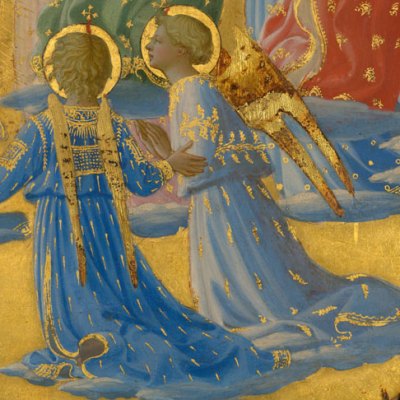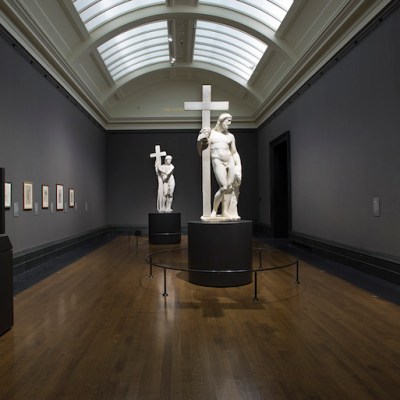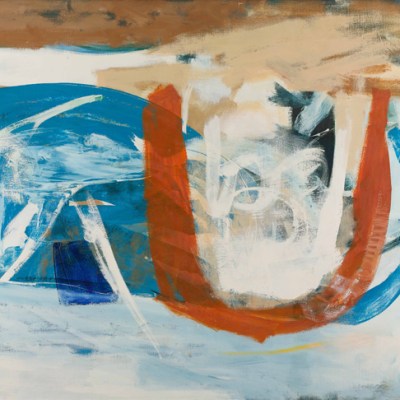The heavy-duty collection catalogue first saw the light of day in London’s very own National Gallery. The original edition of Martin Davies’ catalogue, The Earlier Italian Schools, was published in 1951, and the second (revised) edition came out in 1961. This latter ran to a mighty 623 pages, and cost 15 shillings (75p), but – before anyone reaches for their handkerchief to brush away the tears – it is important to add that it was austerely unillustrated. In every other respect, it set a new standard for such publications, and perhaps not coincidentally the next quantum leap also took place in Trafalgar Square.
 In 1998, under the inspired leadership of Neil MacGregor, Judy Egerton’s The British School and Lorne Campbell’s The Fifteenth Century Netherlandish Schools both ushered in an altogether different order of scholarship. Campbell’s catalogue entry on what he refers to with caution as the Portrait of Giovanni (?) Arnolfini and his Wife fills no fewer than 38 double-column pages, includes 27 illustrations, and a hair-raising 312 footnotes. An impressive seven subsequent NG catalogues (one in two volumes) have followed their lead in the intervening two decades, and a select number of other institutions have taken up the gauntlet.
In 1998, under the inspired leadership of Neil MacGregor, Judy Egerton’s The British School and Lorne Campbell’s The Fifteenth Century Netherlandish Schools both ushered in an altogether different order of scholarship. Campbell’s catalogue entry on what he refers to with caution as the Portrait of Giovanni (?) Arnolfini and his Wife fills no fewer than 38 double-column pages, includes 27 illustrations, and a hair-raising 312 footnotes. An impressive seven subsequent NG catalogues (one in two volumes) have followed their lead in the intervening two decades, and a select number of other institutions have taken up the gauntlet.
In Germany, among the major collections of Italian Renaissance paintings, only the Städel in Frankfurt’s publication of Rudolf Hiller von Gaertringen’s Italienische Gemälde im Städel 1300–1550: Toskana und Umbrien (2004), which weighs in at 565 pages as against the present volume’s 744, represents a genuine precedent. Like this catalogue of Munich’s Florentine paintings, the Frankfurt volume confines itself to only a part of the Italian Renaissance holdings; but there are a number of important differences.
Adoration of the Child (c. 1495), Fra Bartolommeo. Alte Pinakothek, Munich Image: © Bayerischen Staats-gemäldesammlungen, Alte Pinakothek, Munich

Arguably the most obvious to anyone merely flicking through both of them is that the Frankfurt volume has a selection of 65 colour plates near the front, but is otherwise illustrated in black and white, whereas the Munich volume (German edition only) is almost wholly in colour, not least when it comes to comparative illustrations. This is a real bonus, and the only Homeric nod is the unfortunate reversal of the image in Figure 1.10. Interestingly, the 56 entries are not the work of a single author, but are instead shared out between Andreas Schumacher, Annette Kranz, Annette Hojer and Cornelia Syre, with additional technical contributions from Daniela Karl and Ulrike Fischer.
The Annunciation (c. 1443/45), Fra Filippo Lippi. Alte Pinakothek. Image: © Bayerischen Staats-gemäldesammlungen, Alte Pinakothek, Munich

Nevertheless, the most telling of all the ways in which this catalogue breaks new ground is in the fact that it boasts a hundred pages or so of introductory material before we get to the catalogue entries. This is fairly evenly divided into two halves, with the first part given over to the history of the collection and to an overview of Florentine painting of the period, and the second part to three technical essays, respectively concerning painting technique, paint media, and pigments. Inevitably, the first of these contributions is of strictly local interest, but tells its story in exemplary fashion, and includes ‘the one that got away’ – Raphael’s Portrait of Bindo Altoviti, which was sold in 1938 and is now in the National Gallery of Art in Washington. Conversely, all the other essays are concise but at the same time impeccably well-informed introductions to their various subjects, and the one on Florentine painting is particularly instructive in its examination of the topic under various headings – altarpieces, devotional paintings, convention and innovation, patronage, and workshop practice. It is hard to think of a better place to go for guidance if one wants to start thinking about such matters, assuming German is no barrier.
Turning to the entries themselves, which are organised in chronological as opposed to alphabetical order, they follow a general formula, although it necessarily varies from entry to entry, depending upon what is and is not known about the work in question. In view of the fact that a review of this kind cannot attempt a comprehensive discussion of all the entries, it makes sense to look at one in detail to give a flavour of what this extremely impressive volume accomplishes.
Unsurprisingly, my choice falls on one of the absolute highlights of the collection, Leonardo da Vinci’s Madonna of the Carnation (no. 22, entry by Andreas Schumacher). Here, the main text is subdivided under no fewer than five – in the main multiple – headings (Provenance and Acquisition; Patron and Early Provenance; Representation, Precedents, Iconography; Artistic Aims; and Attribution), while the technical section (by Daniela Karl) adds three more (Support; Painting Technique; and Later Alterations and Condition).
Madonna of the Carnation (c. 1475), Leonardo da Vinci. Alte Pinakothek. Image: © Bayerischen Staats-gemäldesammlungen, Alte Pinakothek, Munich

Of these sections, the one on Provenance and Acquisition proves to be of peculiar fascination, not least because the panel itself emerged pretty much from nowhere in 1886, at a local auction in Günzburg, where it and its frame fetched a princely 47 marks and 50 pfennigs. Three years later, it was shown to the authorities at the Alte Pinakothek, who thought it was the joint work of Lorenzo di Credi and Leonardo. The director, Franz von Reber, then acquired it for 800 marks, although he actually estimated its value at 10,000. It was soon widely recognised as the work of Leonardo alone, at which point Reber arranged for the vendor to be decorated with the knightly order of St Michael (4th class).
For the rest, the entry is a model, not only because it achieves such an enviably sure-footed balance between detailed observation and understanding of the work itself, and a refreshingly wide-ranging sense of the bigger picture of which it forms such an important part, but also because it is not afraid to discuss artistic quality. One can only hope that further catalogues of the collections of the Alte Pinakothek are on the way, and that they will manage to match the dauntingly high standards set by this mighty tome.
Florentiner Malerei Alte Pinakothek: Die Gemälde des 14. dis 16. Jahrhunderts by Andreas Schumacher with Annette Kranz and Annette Hojer is published by Alte Pinakothek-Deutscher Kunstverlag (€78).
From the March issue of Apollo. Preview and subscribe here.



